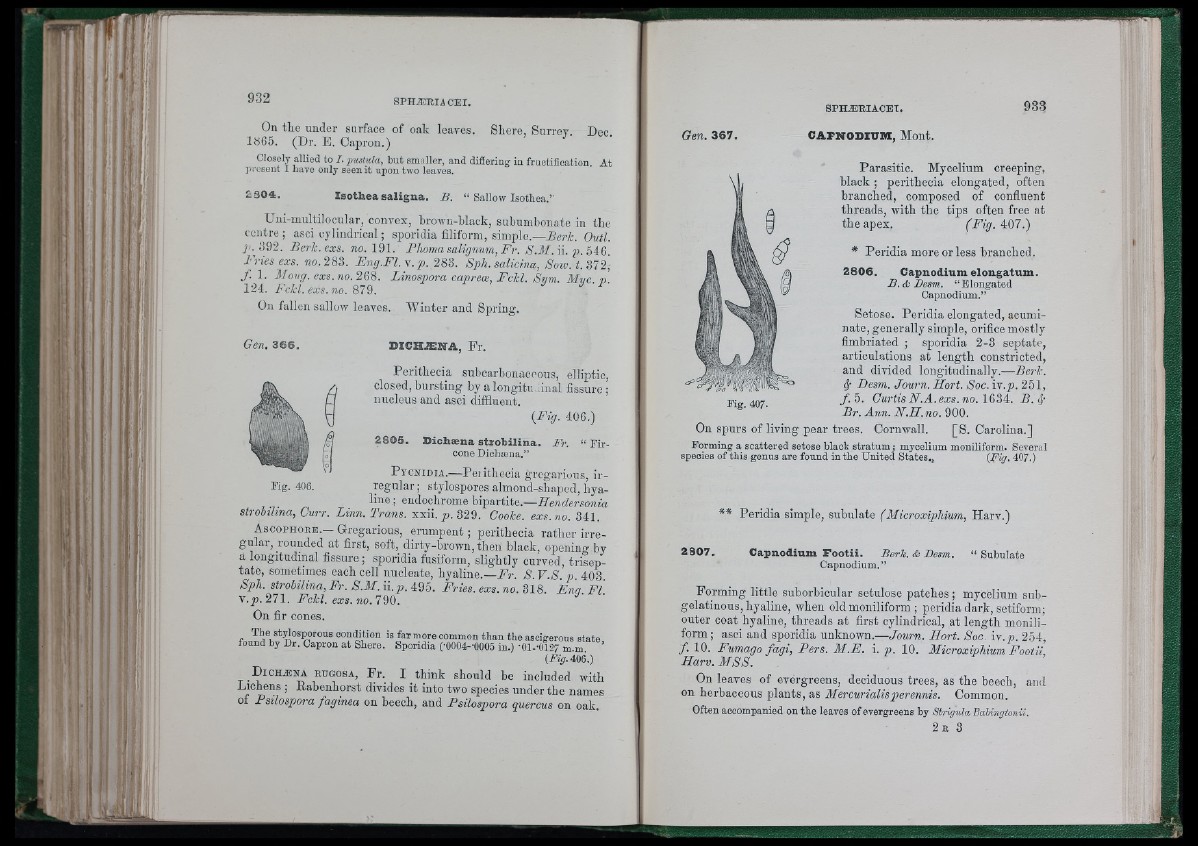
On the under surface of oak leaves. Shore, Surrey. Dec.
18G5. (Dr. E. Capron.)
Closely allied to I. pustula, but smnller, and differing in fructification. At
jHcsent i liave only seen it upon two leaves.
£ 3 0 4 Iso th e a s a lig n a . JB. “ Sallow Isothea.”
Uui-mnltilocnlar, convex, brown-black, subunibonate in the
ceiitre ; asci cylindrical ; sporidia filiform, simple.—Berk. Outl.
7'. 392. Berh. exs. no. 191. Fhomasalignum,Fr. S.M.H. p.546.
Fries exs. wo. 283. Fng.Fl. v .p . 283. Sph. salicina, Sow.t. 372,
J. 1. Along, exs.no. 268. Linospora caprem, Fchl. Sym. Myc. p.
124. Fchl. exs.no. 879.
On fallen sallow leaves. Winter and Spiring.
Gen, 3 6 6 . DICHIENA, Pr.
Perithecia subcarbonaceous, elliptic,
closed, bursting by a longitn.hual fissure ;
nucleus and asci diffluent.
{Fig. 4 0 6 . )
2 8 0 5 . Dichæna s t io b ilin a . Fr.
cone Dichæna.”
“ Mr-
PvcNiDiA.—Petitliecia gregarious, ir-
Fig. 406. regular ; stylospores almond-shaped, hyaline
; endochrome bipartite.— Hendersonia
strohilina, Curr. Linn. Trans, xxii. 79. 329. Coohe. exs.no. 341.
A s c o p h o k e .— Gregarious, erumpent; perithecia rather irregular,
rounded at first, soft, dirty-brown, then black, opening by
a longitudinal fissure ; sporidia fusiform, slightly curved, triseptate,
sometimes each cell nucleate, hyaline.—Ur. S .V .S . p. 4 0 3
Sph. strohilina, Fr. S.M. ii.79. 4 9 5 . Fries, exs. no. 3 1 8 . Fng. F l
V .79. 2 7 1 . Fchl. exs. no. 790.
On fir cones.
The strtosporous condition is far more common than the ascigerous state
found by Dr. Capron at Shere. Sporidia (■0004--0005 in.) ■01--0127 m.m ’
(F ig .im .)
D i c h æ n a r u g o s a , Pr. I think should he included with
Lichens ; Rabenhorst divides it into two species under the names
of Psilospora faginea on beech, and Psilospora quercus on oak.
Gen. 3 6 7 .
S P H Æ E IA C E I .
CAFKTODIVia, Mont.
Fig. 407.
Parasitic. Mycelium creeping,
black ; perithecia elongated, often
branched, composed of confluent
threads, with the tips often free at
the apex. (Fig. 407.)
* Peridia more or less branched.
2 8 0 6 , Capnodium elonga.tum.
B . dk JDesm. “ Elongated
Capnodium.”
Setose. Peridia elongated, acuminate,
generally simple, orifice mostly
fimbriated ; sporidia 2-3 septate,
articulations at length constricted,
and divided longitudinally.—Berh.
& Desm. Journ. Hort. Soc. iv.79. 251,
f .5 . Curtis H. A. exs. no. 1634. B.&
Br. Ann. N.H.no. 900.
On spurs of living pear trees. Cornwall. [S. Carolina.]
Forming a scattered setose black stratum; mycelium moniliform. Several
species of this genus are found in the United States., {Fig. 407.)
** Peridia simple, subulate (Microxiphium, Harv.)
2 8 0 7 . Capnodium F o o tii. Berh. & Besm. “ Subulate
Capnodium.”
Forming little suborhicular setulose patches ; mycelium subgelatinous,
hyaline, when old moniliform ; peridia dark, setiform;
outer coat hyaline, threads at first cylindrical, at length moniliform;
asci and sporidia unknown.—Jhwrw. Hort. Soc. iv.79. 254,
/ . 10. Fumago fagi, Pers. M.F. i. p. 10. Microxiphium Footii,
Harv. M S S .
Cn leaves of evergreens, deciduous trees, as the beech, and
on herbaceous plants, as Mercurialis perennis. Common.
Often accompanied on the leaves of evergreens by Strigula Balingtonii.
2 r 3